Starting a new job is kinda like the first day at a new school. You don’t know where the coffee machine is, you don’t know if everyone eats lunch together, and you definitely don’t know which Slack channel is safe for memes. That’s why a **“**welcome to the team” message—short, long, formal, playful, whatever, or even a formal message for professional settings—actually matters more than most people admit.
Because here’s the thing: that first touchpoint sets the tone. Welcome messages for new employees play a crucial role in making newcomers feel recognized, appreciated, and integrated into the team. If it feels cold and generic, the new hire assumes the culture is too. If it feels warm and specific—“Hey Sarah, we’re thrilled to have your design brain here, and yes, Fridays we do burrito runs”—suddenly it’s not just a job. It’s belonging. And that’s half the battle won.
(And if you’re wondering how to actually manage all those intros, emails, and onboarding syncs without losing your mind—spoiler, tools like Wellpin can automate the messy scheduling part. Which means you can focus on the human side.)
Understanding Welcome Messages
Importance of Welcome Messages
A welcome to the team message isn’t just a polite checkbox. It’s your organization’s first impression after the contract is signed. Think of it as that moment when someone finally hands you the keys to your apartment, not when you signed the lease. That’s when it feels real.
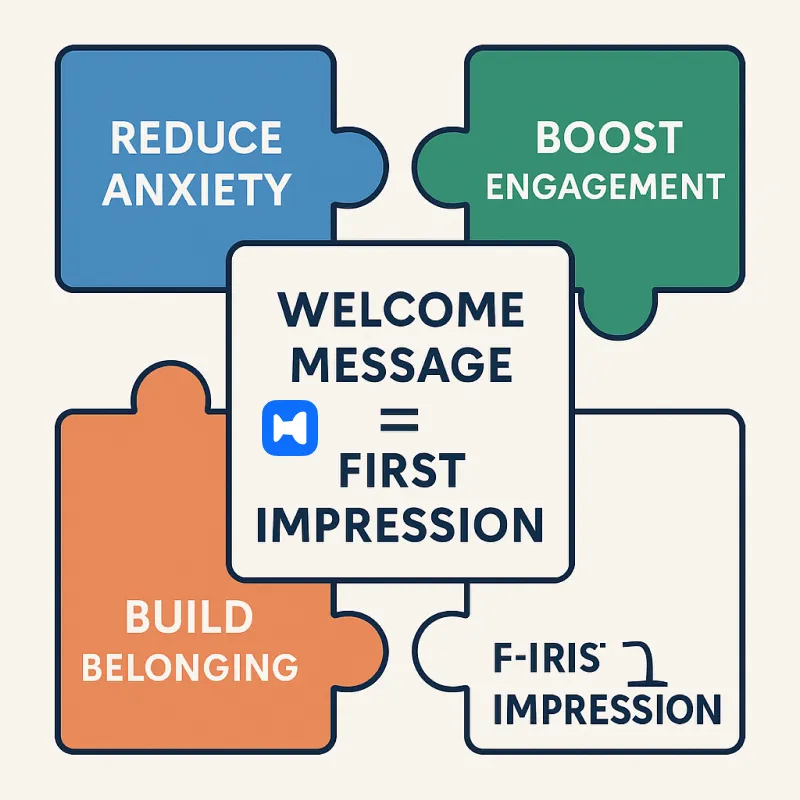
Done right, a welcome email to a new employee can reduce anxiety, boost early engagement, and help the new hire hit the ground running. A good welcome message should be thoughtfully crafted to foster engagement, build a sense of belonging, and effectively introduce company culture. Done wrong—or skipped entirely—and you risk weeks of awkwardness. People might not say it out loud, but they remember how they were brought in.
And honestly? In a world where half of us are remote, hybrid, or in another timezone entirely, a thoughtful message is the digital equivalent of walking them to their desk and saying, “We’re glad you’re here.” Showing that you are genuinely excited in your communication helps create a positive first impression.
All of these efforts contribute to building a welcoming environment for new hires.
Key Elements of a Successful Welcome Message
So what makes a message land? A few things, actually: A well crafted message helps set a positive tone and makes the new hire feel valued right from the start.
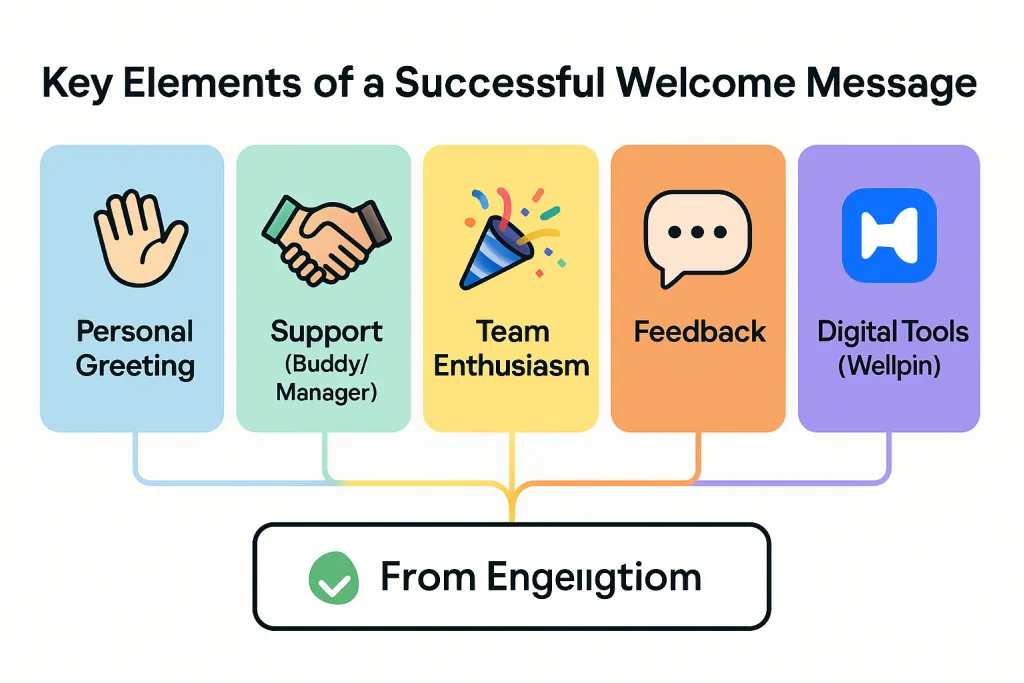
- Personal greeting – Names matter. “Welcome, Alex” hits different than “Dear Employee.”
- Offering support – Point them toward a buddy, a manager, or that one person who actually knows how the printer works.
- Amplifying team excitement – Let them know it’s not just HR that’s happy—the entire team is involved in the welcome process, which fosters a sense of community.
- Encouraging feedback – Even in week one, they should feel it’s okay to speak up.
- Integrating digital tools – This is where Wellpin sneaks in like the unsung hero. Scheduling a first team huddle, setting up intro coffee chats, automating reminders—it makes sure the good intentions in your message don’t die in someone’s crowded inbox.
Because let’s be real: sending a warm note is great. But following it up with actual action (like getting them into their first group meeting without 12 back-and-forths) is what turns a “welcome” into a full onboarding experience. These steps help ensure a smooth transition for the new hire.
Company Culture and Values
Company culture and values are the heartbeat of any organization, and they play a pivotal role in shaping the experience of new employees from day one. When a new hire receives a welcome message that genuinely reflects the company’s culture, it does more than just say “hello”—it signals what it truly feels like to be part of the team. For new employees and new hires, this first impression can set the stage for how they’ll engage, collaborate, and grow within the company.
A well-crafted welcome message is your chance to showcase what makes your workplace unique. Whether your company thrives on innovation, teamwork, or a passion for customer service, letting those values shine through in your communication helps new hires feel aligned with the mission from the start. It’s not just about making them feel welcome; it’s about inviting them to be part of something bigger and giving them a glimpse into the company culture they’re about to join.
Reflecting Culture in Your Welcome
A warm welcome message that truly reflects your company culture can make all the difference for new employees stepping into their new role. Instead of a generic greeting, consider weaving in elements that highlight your organization’s personality and what you stand for. For example, if your team is known for its creativity and out-of-the-box thinking, encourage new hires to bring their fresh ideas and unique perspectives to the table right from the start.
You might mention a beloved team tradition, reference a recent company achievement, or simply express genuine excitement about the new hire’s potential contributions. By doing so, you’re not just welcoming someone to a job—you’re inviting them into a community where their voice matters. A warm welcome message that echoes your company culture helps new employees feel connected, valued, and ready to make an impact with their fresh ideas.
Communicating Core Values
A thoughtful welcome message is also the perfect opportunity to communicate your company’s core values. When new employees understand what drives the organization—whether it’s collaboration, integrity, or a relentless focus on customer satisfaction—they’re better equipped to become a valuable asset to the team.
A well written welcome message might highlight how teamwork is at the heart of every project, or how innovation is encouraged at every level. By clearly stating these values during the onboarding process, you help new hires see how their work will contribute to the company’s mission and success. This clarity not only motivates new employees but also sets clear expectations, making it easier for them to integrate and thrive. A thoughtful welcome message that communicates core values ensures every new hire feels like a valuable addition from day one.
Types of Welcome Messages
Not all welcome to the team messages are created equal. Sometimes you need buttoned-up and professional, sometimes you want casual and fun, sometimes you’re talking to a remote hire who hasn’t even seen the office kitchen yet. The trick is matching the tone to the context. Using the right approach helps new hires feel comfortable and integrated into their new team.
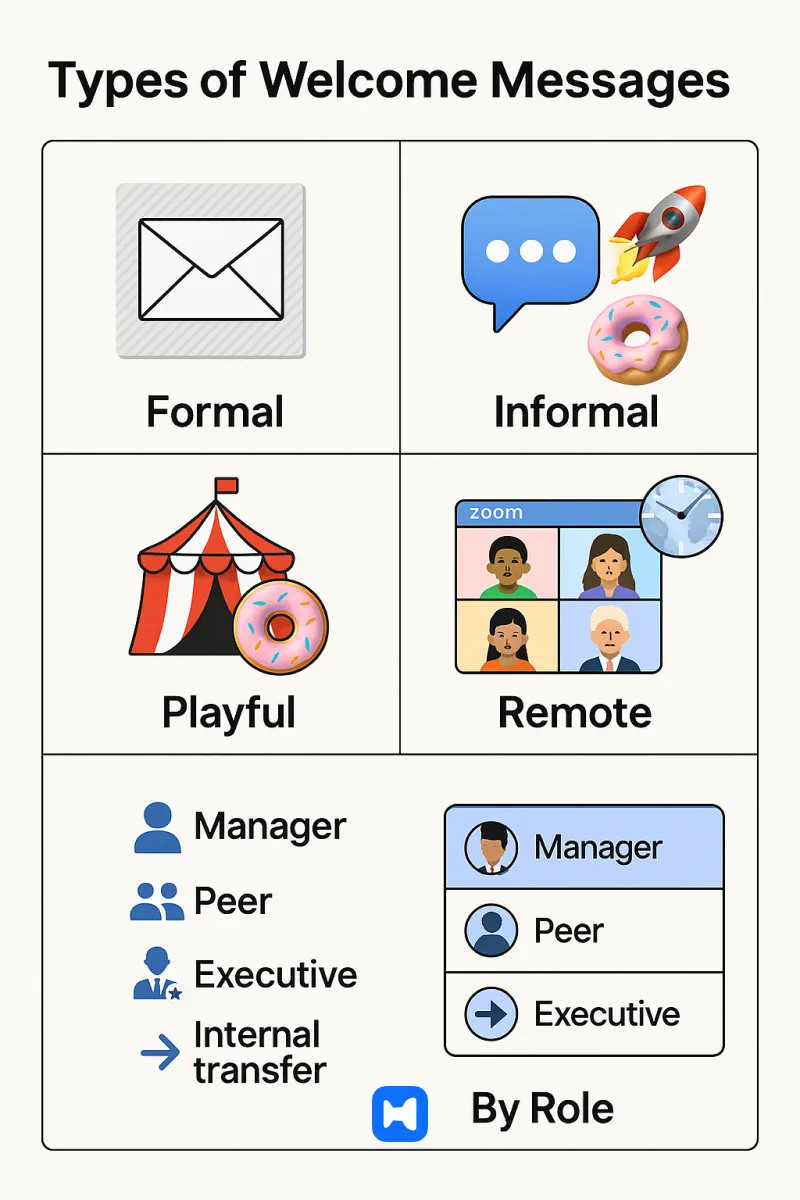
Formal Welcome Messages
For industries where professionalism isn’t optional—think finance, legal, healthcare—you’ll want something polished. No GIFs. No inside jokes (yet). Just clarity, support, and warmth. A formal message can also communicate the company's mission forward and set expectations for the new hire's role in advancing strategic goals.
Example:
Dear Maria, welcome to our team as our new Data Analyst (job title). We are delighted to have your expertise in data analysis and look forward to your contributions. Your start date is June 12th (hire's start date), and our business casual dress code will help you feel comfortable from day one. Your manager will connect with you this week to schedule your onboarding sessions through Wellpin. Please don’t hesitate to reach out if you need anything in the meantime.
Formal messages like this often include information about new hire orientation to help employees prepare for their first days and feel supported as they join the company.
Notice the subtle nod to logistics? That’s where a booking system app like Wellpin makes life easier. Instead of attaching three calendar invites that conflict with half the team’s schedules, you just drop in a Wellpin link. Done.
Informal Welcome Messages
When the vibe is more “startup hoodie” than “three-piece suit,” informality works wonders. Short, enthusiastic, and personal.
Example:
Hey Jason! Welcome aboard 🚀 We’re absolutely thrilled to have you join our dynamic team. We’ve been waiting for someone with your unique skills in product design. Heads up: we’ve got a kick-off team call scheduled tomorrow (thanks to Wellpin for making it painless to set up). Bring coffee. And opinions.
Playful Welcome Messages
Sometimes you don’t need polish or simplicity—you need energy. Something that makes the new hire grin before they’ve even logged into Slack.
Example:
Welcome to the circus, Emma! 🎪 Don’t worry, we’ve got safety nets (and donuts on Mondays). You’re just what our team needed, and together we’ll make some magic happen and accomplish amazing things. Your first Wellpin-invited meeting is on Thursday—no lions, just the product team. We’re thrilled you’re here.
Remote Employee Welcome Messages
A welcome email to a new employee working remotely has to work a little harder. No office tour, no casual desk visits. You’re building connection entirely through words and screens.
Example:
Hi Ravi, welcome to the team! Since we’re spread across three continents, Wellpin already scheduled your intro chats with the key folks you’ll work with. No timezone math required. To help you get started, you’ll receive our employee handbook with essential information about our work environment, and you’ll be introduced to key team members so you can quickly feel part of the team. We can’t wait to see what you bring to the table—even if it’s a virtual one.
Welcome Messages for Different Roles
Sometimes the “welcome” shifts depending on the role. For example, the onboarding process may differ if someone is starting a new position within the company or joining as a new member of the team. A manager’s intro looks different than a peer’s or a C-level exec’s.
- For Managers
We’re excited to welcome you as our new Marketing Manager. Your leadership will play a vital role in shaping our next chapter. Wellpin has already set up a team meeting this Friday so you can meet all the new team members face-to-face.
- For Peers
Hey Taylor—so glad you’re joining us! The design team has been buzzing about you. We’ve got a group lunch scheduled (yep, Wellpin again) to properly introduce you. We know your unique background will be a great addition to our team member's collective strengths.
- For Executives
We’re honored to welcome you as our new Chief Operating Officer. Your expertise will guide our strategy forward. Wellpin has organized your first cross-departmental alignment session to ensure a seamless start.
- For Internal Transfers
Congrats on your new role, Dana! You’ve been crushing it in support, and now the sales team gets to benefit. We’re excited to welcome you as a new team member to your new group. Wellpin already arranged your first few client shadowing calls.
Best Practices for Writing Welcome Messages
Writing a welcome to the team message is deceptively tricky. Too cold and you sound robotic. Too gushy and it feels fake. The sweet spot is where clarity meets warmth, and where the person reading actually feels part of something. Reviewing message examples can help you craft a well crafted message that makes the new hire feel like a great asset to the team.
Personalization
If your welcome message could be copy-pasted for anyone, you’ve already lost. Use the person’s name. Reference their role. Mentioning the new hire's background or interests can make the message feel more personal. Maybe even sneak in something you know about them from the interview—like their obsession with UX microcopy or the fact they make a mean sourdough starter.
**Bad:**Welcome to the team. We are glad you’re here.**Better:**Welcome to our team, Aisha! The dev squad can’t wait to geek out with you on accessibility testing.
Wellpin helps here by pulling role-specific onboarding workflows into the calendar automatically, so the “welcome” feels tailored instead of generic.
Setting the Right Tone
Tone matters. A short welcome message for a new employee joining your accounting department isn’t going to look the same as a Slack post introducing a social media intern. Match the formality to the culture and the role. The tone of your message should also reflect the company's culture to help set expectations for the new hire.
And don’t be afraid of showing personality. If your team laughs a lot, your message should reflect that. If your org is buttoned-up, keep it crisp.
Including Key Information
A welcome note shouldn’t just be fluff. Make it useful. Drop in links to onboarding docs, the first-week agenda (yes, ideally scheduled via Wellpin so nobody’s juggling invites), who their go-to people are for questions, and be sure to include the new hire's start date in the welcome message.
Think of it as half-greeting, half-roadmap.
Showing Enthusiasm
Don’t undersell it. This is someone’s first impression of your team culture. Enthusiasm is contagious, and it signals that you actually want them there—not that they’re just filling a seat. Demonstrating genuine enthusiasm in your welcome message helps new hires feel valued and supported right from the start.
A sprinkle of emojis in informal messages? Sure. An exclamation mark or two in more formal emails? Totally fine.
Encouraging Open Communication
The real killer of new-hire energy is silence. If your message makes it clear they can ask questions, you’ve already lowered the barrier for them to actually speak up.
Even something as small as: “Ping me anytime on Slack if you get lost in the maze of acronyms.” It matters.
Timing Your Message
Here’s one a lot of teams forget: don’t wait until the end of Day 1 to say welcome. Send it before they start. Even better, schedule it to arrive the morning of their first day using Wellpin. That way, their inbox greets them with positivity instead of HR paperwork.
Follow-Up Strategies
A welcome message isn’t a one-and-done. Follow up after week one. Then again after the first month. Use it as a touchpoint: “How’s onboarding feeling so far? Anything you’re stuck on?”
And honestly, let tech do the heavy lifting—Wellpin can automate those check-ins so managers don’t have to rely on memory alone.
Measuring Success
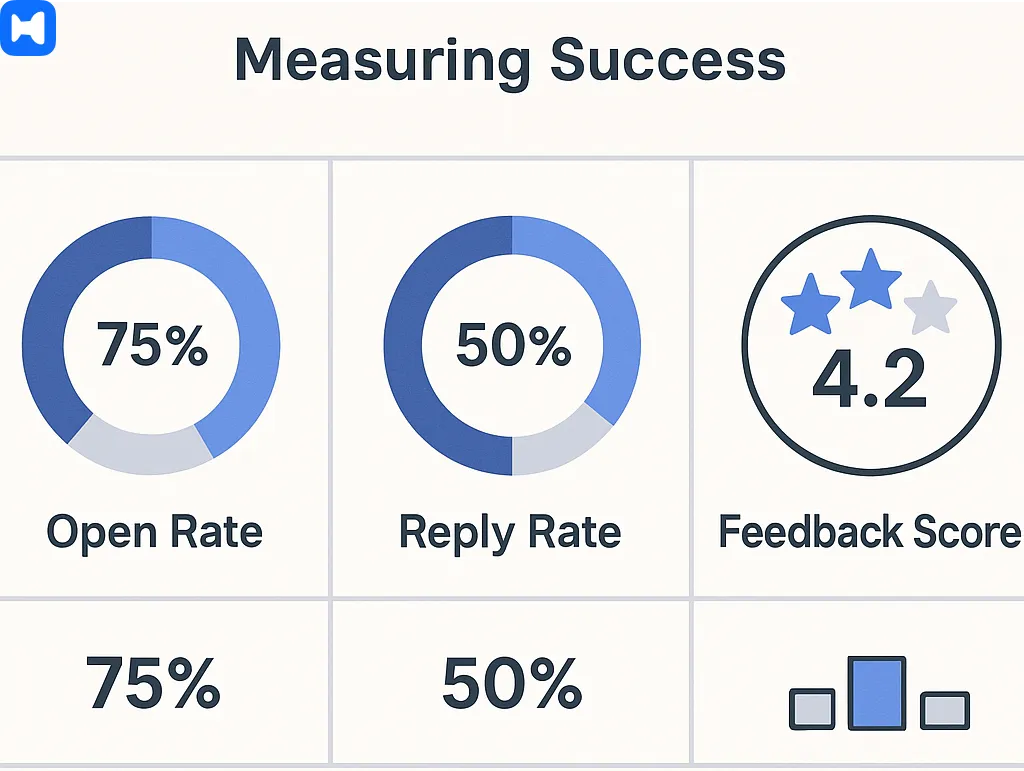
Crafting the perfect welcome messages is only half the battle—the other half is making sure they actually work. Measuring the success of your welcome messages helps you understand their positive impact on new employees and identify ways to make the onboarding process even better. By keeping an eye on how new hires respond, you can ensure your efforts are setting the right tone and paving the way for a long and successful journey with your company.
Tracking Engagement and Feedback
To truly know if your welcome messages are hitting the mark, it’s important to track engagement and gather feedback from new employees. Start by monitoring simple metrics like email open rates and response rates—these can give you a quick snapshot of how many new hires are actually reading and reacting to your messages. Go a step further by sending out short feedback surveys after the onboarding process, asking new employees how the welcome message made them feel and if it helped them settle in.
Analyzing this feedback can reveal what resonates most and where there’s room for improvement. For example, you might discover that new hires who receive a personalized, well-crafted welcome message are more likely to engage with their team and feel positive about their new role. By acting on these insights, you can fine-tune your approach and ensure every new employee starts their journey with a positive tone and a sense of belonging. In the end, a great welcome message can make all the difference, setting the stage for a long and successful journey with your company.
Common Mistakes to Avoid in Welcome Messages
Even the best-intentioned welcome email to a new employee can land flat if you’re not careful. Some of these mistakes are subtle, but they add up fast and can set the wrong tone before the person’s even logged into their first Zoom.
Being Too Generic
“Welcome to the team, we’re happy to have you.” That’s it? That’s all you’ve got? Generic, boilerplate stuff screams afterthought. A new hire wants to feel like this message was written for them.
Fix it: Personalize. Use details. Even one sentence that ties back to their role—or how excited a specific team is to work with them—makes all the difference.
Overloading with Information
Some teams get a little too eager. They send a welcome to the team message that reads like a 20-page onboarding manual. No one’s reading that on their first day, trust me.
Instead, keep it light and useful. Attach a link (or better, schedule an onboarding session in Wellpin) so they know when and how they’ll get the deeper dive.
Forgetting the Human Touch
Tone-deaf welcomes feel like corporate policy. If your message could have been generated by a dusty HR handbook from 1999, you’ve already lost the vibe.
Throw in something real. A team joke. A “coffee’s on me when you’re in the office” line. Even a light emoji in the right context. (Not saying bombard them with 🎉🎉🎉, but one can work wonders.)
Ignoring Timing
The timing mistake is brutal. Sending the message a week late or after they’ve already had three stressful onboarding calls makes it meaningless.
That’s why teams are increasingly automating this with tools like Wellpin—ensuring the welcome note and first-week calendar are locked in ahead of time, so it feels intentional rather than reactive.
Failing to Follow Up
One message isn’t enough. The worst mistake is thinking “welcome” is a box to tick. By week two, the shine has worn off, and that’s when support is really needed.
Follow-ups—scheduled automatically with Wellpin if you don’t trust your memory—show the new hire they’re not just another onboarding checklist.
Conclusion: Building a Culture That Starts With “Welcome”
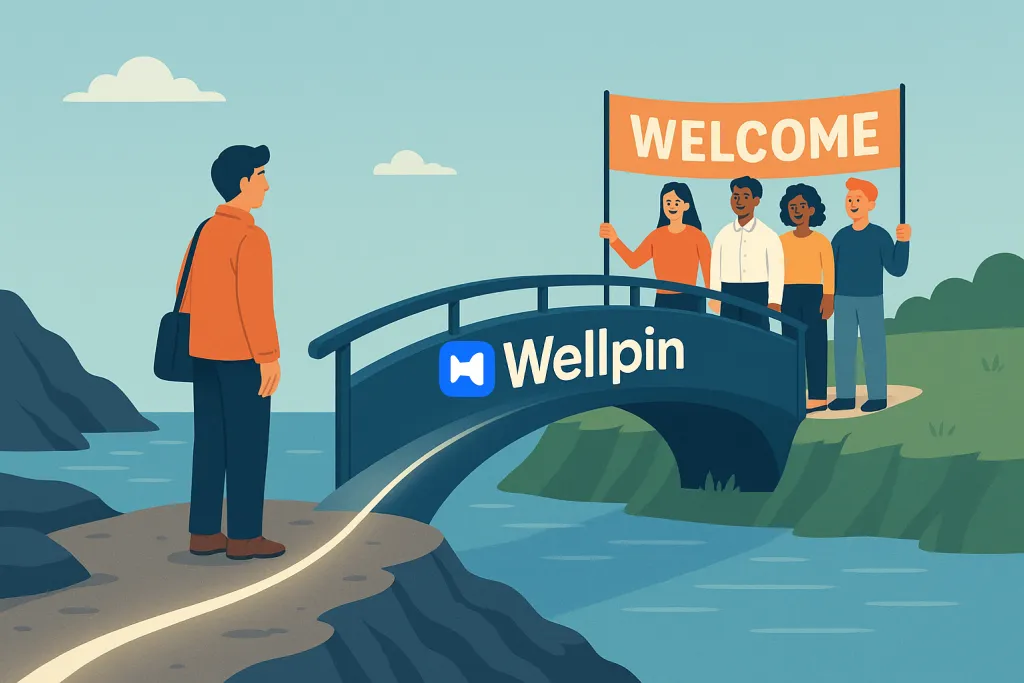
At the end of the day, a welcome to the team message isn’t just a polite gesture. It’s the first brick in the foundation of how your new employee will view your culture, your team, and maybe even their future in your company.
Get it right, and you create momentum. You make people feel like they belong before they’ve even found the office coffee machine or figured out which Slack channel is safe for memes. Get it wrong, and… well, it takes a long time to fix that first impression.
The best welcomes are personal without being overbearing, structured without being stiff, warm without slipping into cheesy. It’s a balancing act. But when you combine a thoughtful message with smart scheduling and structured follow-up—suddenly it’s not just onboarding, it’s engagement from day one.
That’s where tools like Wellpin shine. Instead of scrambling to remember who needs a note, when the first check-in should be, or if someone got their kickoff invite, Wellpin automates the chaos. Your HR team sets the tone once, and the platform makes sure every new hire feels like they landed somewhere intentional, organized, and—most importantly—human.
Because here’s the truth: people don’t remember the exact wording of your “welcome email to new employee.” But they absolutely remember how it made them feel.
So, make it count.

.webp)


